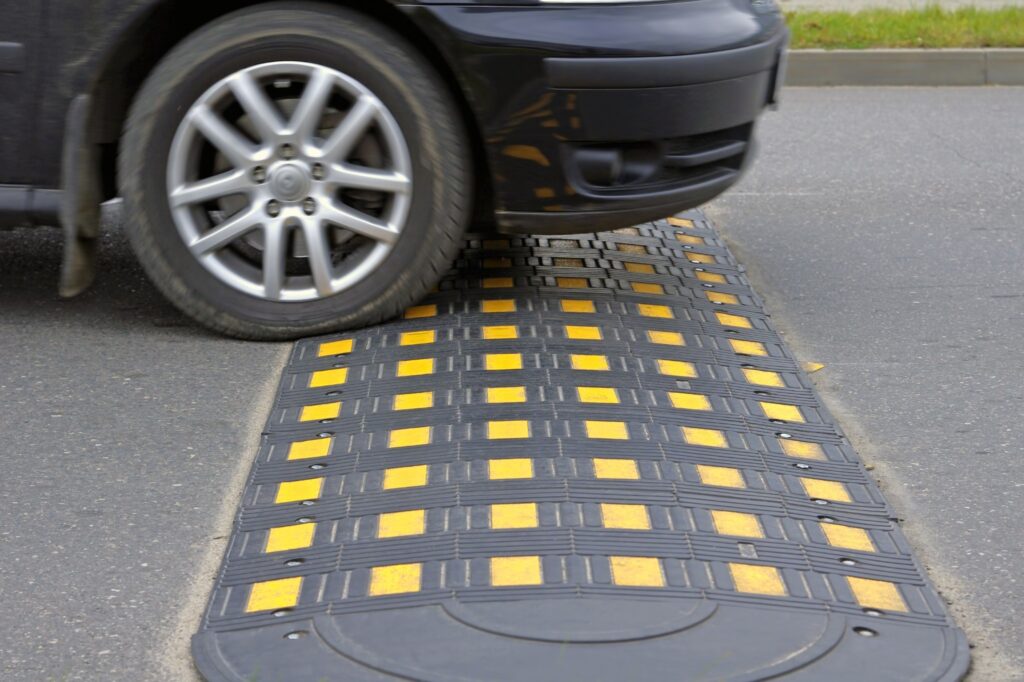Speed bumps are vertical speed control elements designed to slow down vehicles on low-volume and low-speed roads in residential areas. While failing to slow down when approaching a speed bump may appear harmless, it can cause damage to your vehicle that may end up requiring costly and complex repairs.
Let’s find out which vehicle components may fail when you aren’t too careful about driving on speed bumps.
Which Parts May Get Damaged When You Drive Too Fast On Speed Bumps?
Failing to drive over speed bumps slowly and safely means you run the risk of damaging critical components of your vehicle. This includes the shock absorbers, the steering system, the exhaust, and the tires.

Shock Absorbers
Your vehicle’s shock absorbers are responsible for controlling the impact and rebound movement from the suspension system. They are hydraulic devices that absorb vibrations and convert the kinetic energy from the movement into heat before dissipating it. This stops rides from feeling bouncy when driving at high speeds or on rough, uneven surfaces.
Steering System
The steering system is a collection of components that help drivers steer and control the vehicle, letting them move forward in the direction of their choosing. The steering wheel is used to turn the pinion gear, which moves the rack back and forth to steer and turn the wheels.
Exhaust System
The exhaust system expels the gases outside the vehicle. It accomplishes this with the help of four components: the exhaust manifold, the catalytic converter, the muffler, and the tailpipes.
The exhaust manifold sends gasses from the engine through the exhaust piping to the catalytic converter, which converts toxic substances such as carbon monoxide, hydrocarbons, and oxides of nitrogen into less harmful gasses. These are then passed through the muffler and on some vehicles a resonator to reduce the noise made by the engine before being released into the atmosphere through the tailpipes.
Tires
A vehicle’s tires are the round components that go around the wheels. They exist to support the vehicle’s load, absorb shock from the road, change and maintain the direction of travel, and give vehicles the traction they need to either speed up or slow down.
What Complications Arise If These Components Get Damaged?
Car damage caused by driving too fast on speed bumps may vary depending on the vehicle’s speed and whether or not the brakes were applied. Damage manifests in many ways, leading to bad shock absorbers, steering issues, a damaged exhaust system, and tire misalignment.
Bad Shock Absorbers
If the shock absorbers get damaged as a result of driving over a speed bump too fast, you might experience these problems:
- Bouncy rides
- Unusual noises
- Leaking hydraulic fluid
- Uneven tire wear
Steering Issues
Driving over a speed bump improperly may cause the following problems:
- Steering difficulty
- Grinding noises when you turn the steering wheel
- Steering wheel drift
- Vibrating steering wheel
Damaged Exhaust System
If you don’t slow down when driving over a speed bump, your vehicle might experience these issues:
- Rattling exhaust
- Reduced engine performance
- Poor fuel efficiency
- Loud engine noises
Misaligned Tires
Driving over a speed bump without care or caution might lead to misaligned tires which may cause these symptoms:
- Unevenly worn tires
- Poor handling
- Squealing tires
- Car pulling to one side
How to Prevent Car Damage from Speed Bumps
Fortunately, there are many ways to prevent or minimize the damage done to cars from driving too fast on speed bumps. These include slowing down, following speed limits, keeping a sharp eye on the road, and refraining from sudden braking when driving over speed bumps.
Slow Down
Speed bumps are designed to slow down vehicles by disincentivizing them from speeding around residential roads and near pedestrian crossings. Driving slowly over speed bumps is one of the best ways to avoid damaging your vehicle.
Follow the Speed Limit
Sticking to the speed limit means you can easily adjust and decelerate your vehicle as you approach a speed bump. Driving responsibly and following the law significantly reduces the risk of damaging your vehicle’s steering and suspension components.
Don’t Get Distracted Behind the Wheel
Always stay alert when you drive, and watch out for speed bumps. This will make it easier to slow down as you approach them.
Avoid Sudden Braking
Whenever you hit the brakes, the front end of your vehicle dips slightly. Suddenly applying the brakes when approaching a speed bump quickly may damage your vehicle’s undercarriage. Instead, take your foot off the accelerator and let your vehicle slow down naturally.
Where to Buy Replacement Shock Absorbers and Other Components
If you hit a speed bump too hard one too many times, you might damage your vehicle’s shocks. The shock absorbers are essential for a comfortable ride, and you don’t want to be driving around feeling every little dip in the road. You can always check CarParts.com in case you need a new set.
CarParts.com’s extensive catalog includes quality aftermarket parts from trusted brands, and we’ve made it easy to browse through our many products. It only takes a few quick clicks to narrow down the selection to the parts you need. You might find even more parts you need for other speed-bump-related incidents. We offer products at different price points to suit any budget, making our site the best place to bargain-hunt.
Find the parts you need to get your vehicle back in tip-top shape. Whether you’re looking for replacement shock absorbers or other parts, buy now at CarParts.com.
Any information provided on this Website is for informational purposes only and is not intended to replace consultation with a professional mechanic. The accuracy and timeliness of the information may change from the time of publication.




















